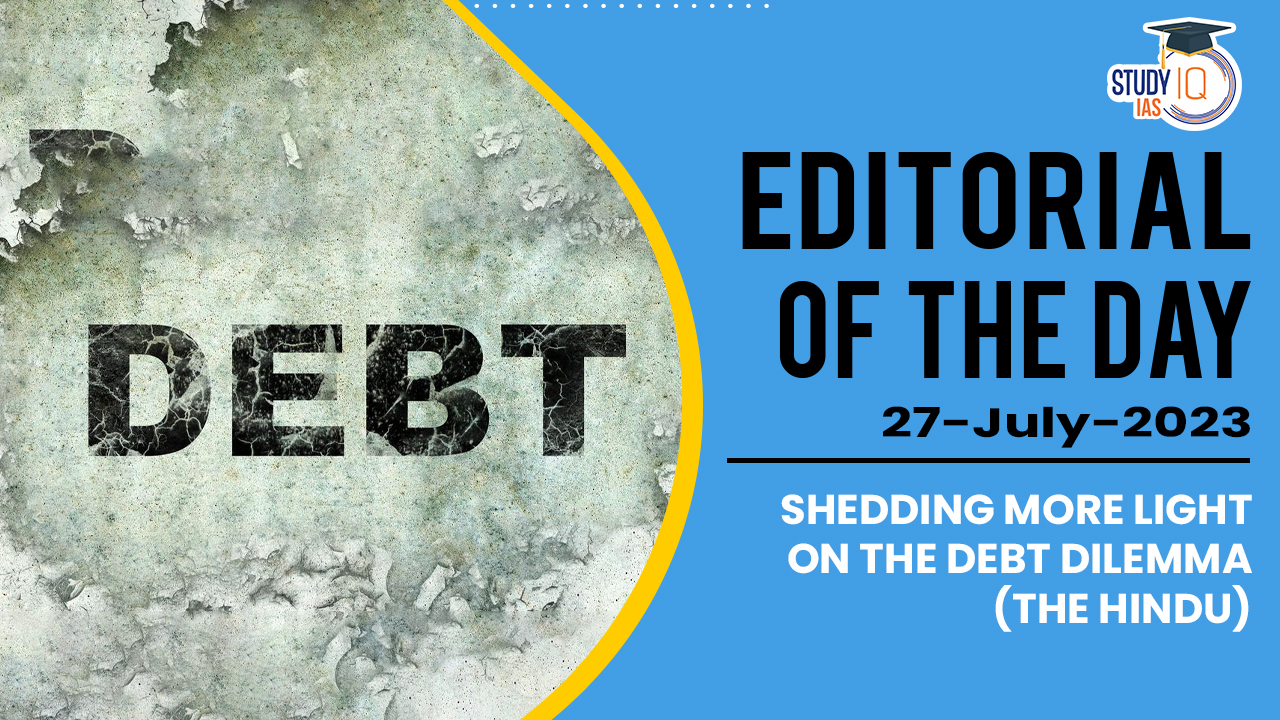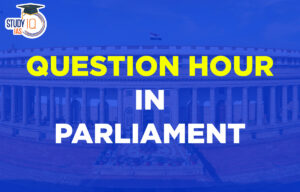Table of Contents
Context: The article is discussing the concerning levels of fiscal deficit and public debt in India, particularly exacerbated by the COVID-19 pandemic. The article highlights the potential impact of the electoral budget cycle, with several state elections scheduled in 2023 and the general election in 2024. During election periods, there is a possibility of increased government spending to win votes, which could further push up the debt ratio. The article emphasizes the importance of targeted interventions to reduce the debt burden. However, such interventions may not be politically easy to implement with elections on the horizon. Therefore, the article suggests that sustainability of the debt as a serious concern, and that addressing this issue would require careful and prudent economic management.
Background
Understanding Fiscal Deficit:
Fiscal deficit is the difference between the government’s total expenditure and its total revenue (excluding borrowings) over a specific period, typically a year. In other words, it represents the amount of money the government needs to borrow to cover its expenses.
Positive Aspects of Fiscal Deficit:
- Increased Government Spending: Fiscal deficit allows the government to spend more on various public services, social welfare programs, infrastructure development, education, healthcare, and other vital areas. This can stimulate economic growth, create jobs, and improve the overall quality of life for citizens.
- Finances Public Investments: Running a fiscal deficit can enable the government to finance long-term investments and development projects, such as building roads, bridges, railways, and other critical infrastructure. These investments can have positive long-term effects on the economy by enhancing productivity and facilitating economic activities.
- Job Creation: By increasing government spending, especially on labour-intensive projects, fiscal deficit can lead to job creation. This, in turn, can help reduce unemployment and boost consumer spending, further supporting economic growth.
Negative Aspects of Fiscal Deficit:
- Increased Debt Burden:
-
- One of the most significant concerns with a high fiscal deficit is the accumulation of government debt.
- When the government consistently spends more than it earns, it must borrow money to cover the shortfall.
- This leads to an increase in the national debt, and the burden of repaying this debt falls on future generations of taxpayers.
- Inflationary Pressure:
-
- Large fiscal deficits can result in higher money supply as the government may resort to printing money to finance its spending.
- This increased money supply can lead to inflation, reducing the purchasing power of the currency and potentially causing prices to rise throughout the economy.
- Crowding out of Private Investment:
-
- When the government borrows heavily to finance its deficit, it competes with the private sector for available funds in the financial markets.
- This increased demand for borrowing can drive up interest rates, making it more expensive for businesses and individuals to borrow, invest, and expand.
- Consequently, it can lead to a decline in private investment and economic growth.
- Balance of Payments Problems:
-
- If a country runs large and persistent fiscal deficits, it may need to borrow from foreign sources to cover the shortfall.
- This can lead to an increase in external debt and put pressure on the country’s balance of payments.
- If the deficit is not effectively managed, it could result in a loss of foreign exchange reserves, making the country vulnerable to external economic shocks.
Decoding the Editorial
India’s Fiscal Deficit:
- Even before the pandemic hit, India’s debt levels were already high compared to other developing countries and emerging market economies.
- However, the pandemic led to a further increase in debt levels.
- In the fiscal year 2020-21, the fiscal deficit reached 13.3% of GDP, and the aggregate public debt rose to 89.6% of GDP.
- As the economy started to recover post-pandemic, the deficit and debt ratios improved to 8.9% and 85.7% of GDP, respectively.
- However, the projections suggest that the debt levels are unlikely to return to the pre-pandemic trajectory in the medium term, even without significant economic disruptions.
Financial Repression:
- Financial Repression:
- The article discusses the concept of financial repression, which refers to measures taken by the government or central bank to keep interest rates on government borrowing artificially low.
- This is done to reduce the cost of servicing the debt.
- Measures like the statutory liquidity ratio (SLR) and open market operations are used to intervene in the market and keep interest rates repressed.
- Debt-Dynamics Equation:
-
- The article mentions the debt-dynamics equation, which states that if there is no primary deficit (fiscal deficit excluding past interest payments), and the growth rate of GDP exceeds the effective interest rate on government bonds, the overall debt will decline.
- Costs of High Deficits and Debt:
-
- Carrying high deficits and debt levels has significant costs to the economy.
- Interest payments on the debt can become a substantial burden, consuming a considerable portion of GDP and government revenue.
- This could lead to crowding out of essential expenditures on education, healthcare, infrastructure, and other important areas.
- Impact on Fiscal Policy: High levels of debt can constrain the government’s ability to implement counter-cyclical fiscal policies and respond effectively to economic shocks.
- Captive Debt Market:
-
- The debt market in India is largely captive, with commercial banks and insurance companies participating primarily to meet SLR requirements.
- This can squeeze resources available for lending to the manufacturing sector, driving up borrowing costs for businesses in that sector.
- Rating Agencies and External Borrowing: High deficits and debt levels can lead to lower sovereign ratings by rating agencies, which, in turn, increases the cost of external commercial borrowing for the country.
- Interstate Debt Disparities: The article mentions specific Indian states (Punjab, Kerala, Rajasthan, and West Bengal) and their relatively high Debt-to-GSDP ratios, indicating disparities in debt levels across states.
- Burden on Future Generations: Accumulating large deficits and debt can lead to a burden on future generations as they will have to bear the consequences and potential repayment of the debt.
Debt Burden:
- Unfeasible Debt-to-GDP Ratio: The author is of the view that achieving the recommended consolidated debt-to-GDP ratio of 58.2% as suggested by the 14th Finance Commission for 2019-20 is currently unfeasible in the medium term. Even before the COVID-19 pandemic, the aggregate public debt had exceeded the recommended level, and the pandemic further increased the debt burden.
- High Debt Levels: The pandemic significantly impacted India’s fiscal situation, leading to elevated debt levels. Despite the recovery in nominal GDP, the debt ratio only marginally declined, indicating a substantial debt burden for every individual in the country.
- Fiscal Consolidation and Fast Pacing: The article emphasises the importance of fiscal consolidation to address the debt burden. Fast pacing fiscal consolidation is considered imperative to manage the high debt levels effectively.
- GST as a Revenue Source: The Goods and Services Tax (GST) has stabilized and is expected to show high growth potential in the medium term. The improved technology platform has helped enhance tax administration and compliance, leading to expectations of an increase in the aggregate tax-GDP ratio.
- Rethinking the Role of the State: The article suggests rethinking the role of the state and vacating activities that could be better handled by the market. It highlights examples of activities where the government continues to invest money, which could be more efficiently handled by the private sector.
- Subsidies and Redistribution: The article advocates for cash transfers rather than subsidizing commodities and services as a more effective way of redistribution without creating unintended resource distortions.
- Enforcing Fiscal Responsibility: It is important to enforce Fiscal Responsibility and Budget Management rules to impose hard budget constraints on states and ensure effective macroeconomic stabilization, primarily the responsibility of the Union government.
Beyond the Editorial
Government Initiatives:
FRBM Act:
- Target for Fiscal Deficit: The FRBM Act sets targets for the government to bring down the fiscal deficit. It aims to limit the fiscal deficit to 3% of the country’s Gross Domestic Product (GDP) by a specified timeline, which was set to be achieved by March 31, 2021.
- Debt Restriction: The Act also imposes restrictions on the government’s debt, mandating that it should be limited to 40% of GDP by a specific target year, which is 2024-25.
- Transparency: The Act aims to introduce transparency in India’s fiscal management systems. It requires the government to present the Medium-Term Fiscal Policy Statement, Macroeconomic Framework Statement, and Fiscal Policy Strategy Statement along with the Union Budget documents in Parliament annually.
- Projection of Fiscal Indicators: The Medium-Term Fiscal Policy Statement must project revenue deficit, fiscal deficit, tax revenue, and total outstanding liabilities as a percentage of GDP in the medium-term.
- Escape Clause in FRBM Act: The Act allows for the invocation of an escape clause in situations of calamity and national security. In such circumstances, the government can deviate from its annual fiscal deficit target to address the crisis effectively.
N K Singh Committee Recommendations:
- Debt as Primary Target: The N K Singh Committee recommended using debt as the primary target for fiscal policy. The government must aim to achieve the debt target by 2023.
- Creation of Fiscal Council: The committee proposed the establishment of an autonomous Fiscal Council with a chairperson and two members appointed by the Centre. The council’s role would be to provide oversight and advice on fiscal matters.
- Clear Grounds for Deviations: The committee suggested that the grounds for the government to deviate from the FRBM Act targets should be clearly specified, ensuring accountability and transparency in the process.
- Borrowings from RBI: According to the committee’s suggestions, the government must not borrow from the Reserve Bank of India (RBI), except when facing a temporary shortfall in receipts. RBI can subscribe to government securities to finance any deviations, and it can also purchase government securities from the secondary market.


 Question Hour in Parliament: Meaning, Ty...
Question Hour in Parliament: Meaning, Ty...
 Daily Quiz 18 July 2025
Daily Quiz 18 July 2025





















